Diseases and pests are the main causes of crop loss and the death of fruit and berry plants. Gooseberries are no exception. Pests that settle on leaves, shoots, and berries reduce the winter hardiness of the plant if not addressed in time, leading to the drying of branches, roots, and foliage, as well as the shedding of flowers and shoots.
Despite the constant introduction of new varieties and hybrids with high immunity, no plant is completely resistant to all infections. To save your gooseberries, it’s crucial to correctly identify diseases and know effective methods for combating pests and diseases.
Table of contents
Common Gooseberry Diseases and Control Methods
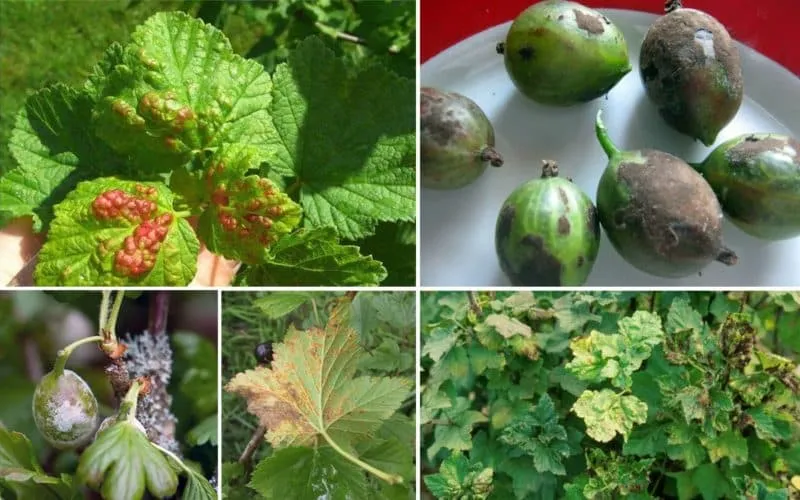
Gooseberry diseases reduce yield and frost resistance, and prolonged exposure can lead to the plant’s death.
Note! Gooseberries are affected by the same infections as currants.
Common causes of diseases include:
- poor care practices;
- weeds;
- temperature fluctuations;
- pests;
- contaminated soil, gardening tools, or planting material.
Powdery Mildew
Powdery mildew – one of the most common gooseberry diseases – is caused by a parasitic fungus. Even resistant varieties can sometimes be affected.
Factors contributing to its spread:
- high humidity and low temperatures;
- extreme heat during droughts;
- lack of sunlight;
- poor air circulation;
- excessive weeds.
Symptoms include:
- white powdery coating on leaves and shoots, easily wiped off initially;
- spread to flowers and berries, covering entire surfaces;
- coating thickens, turns brown, and becomes felt-like;
- affected shoots stop growing, bend, and wither;
- leaves dry and curl;
- fruits crack and fall.
Infected plants lose their yield, photosynthesis is impaired, and winter hardiness declines. Without treatment, the bush dies within 2–3 years.
Treatment: Remove and burn infected parts. Spray with fungicides like Score (a European alternative to "Топаз") for severe cases. For milder infections, use:
- Copper sulfate solution: 1 tbsp per 10 L water.
- Baking soda and soap: 50 g soda + 50 g grated soap in 10 L water.
- Manure solution: 1 kg manure in 2 L water, steep for 3 days, dilute with 9 L water.
- Whey and iodine: 2 L whey + 30 drops iodine in 10 L water.
Apply treatments to infected and neighboring plants, and water the soil around them.
Prevention: Prune annually, mulch soil, avoid overcrowding, and water properly. In early spring, pour boiling water over bushes and soil, then treat with copper sulfate.
Rust
Goblet rust is a fungal disease causing premature leaf and berry drop.
Symptoms:
- rusty spots with orange spore capsules on leaves;
- distorted leaf shape;
- early leaf drop;
- small, misshapen berries that dry and fall.
Fungi survive on fallen leaves and spread via wind.
Treatment: Apply 1% Bordeaux mixture three times. Remove and burn fallen leaves, clear weeds, and mulch soil.
Tip: Choose rust-resistant varieties like Invicta, Hinnonmäki, or Pax.
Anthracnose
A fungal disease causing leaf drop, reduced photosynthesis, and poor fruit quality.
Symptoms:
- small dark-brown irregular spots on leaves;
- spots enlarge and merge;
- leaves dry and fall.
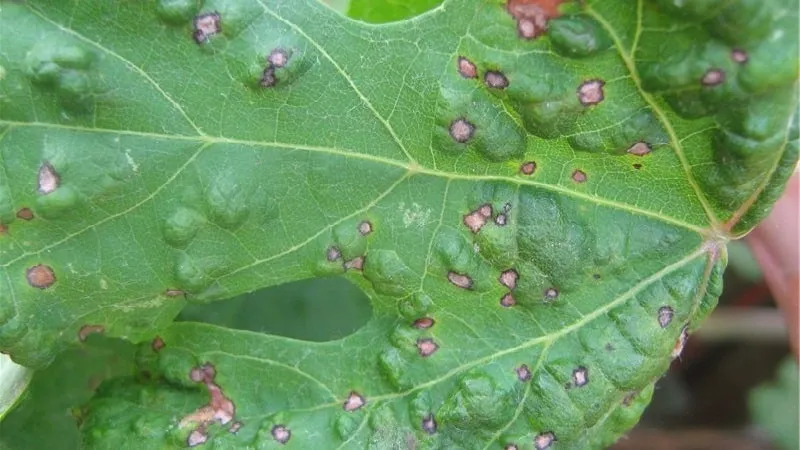
Treatment:
- Copper sulfate: 40 g in 10 L water (early stages).
- Bordeaux mixture: 1% solution applied pre- and post-flowering.
- Ash solution: 1 kg ash in 10 L water + soap, spray weekly.
Remove infected leaves before treatment. For prevention, scald bushes in spring and apply copper sulfate.
Septoria (White Spot)
A fungal disease leading to early leaf drop.
Symptoms:
- small gray-white spots with dark edges on leaves;
- black spore dots appear later;
- leaves curl and dry.
Treatment: Remove infected leaves, spray with copper sulfate or Bordeaux mixture.
Prevention: Burn fallen leaves, loosen soil, and fertilize with micronutrients (zinc, copper, manganese).
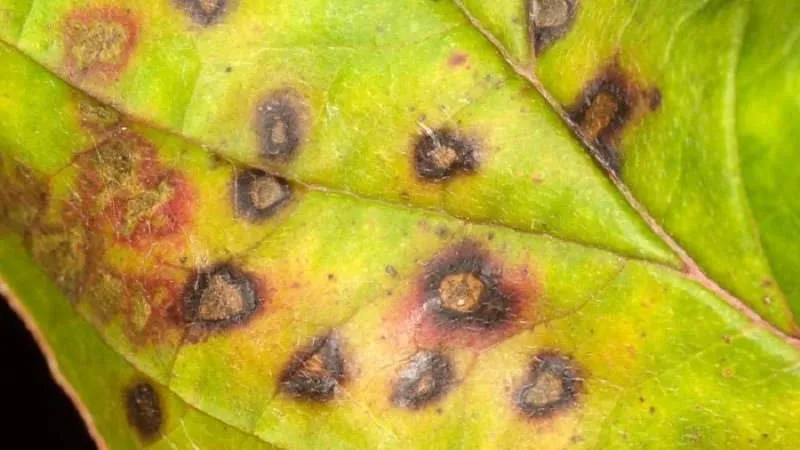
Mosaic Virus
A viral disease spread via tools, pests, or infected plants.
Symptoms: Yellow streaks along leaf veins, shriveled leaves, stunted growth, and low yield.
No cure exists – infected plants must be dug up and burned.
Prevention: Disinfect tools and planting material. Choose resistant varieties.
Scab
Caused by fungi/bacteria, making fruits inedible.
Symptoms:
- brown spots on leaves/shoots;
- green-brown warts on berries;
- deformed, peeling fruits;
- leaf drop.
Treatment: Spray with Fitosporin (organic fungicide).
Gray Mold (Botrytis)
Gray mold affects shoots and berries, causing rot.
Treatment: Apply Teldor (European alternative to "Фундазол") before flowering and post-harvest.
Gooseberry Pests: Identification and Control
Insects damage leaves, fruits, and shoots, and spread disease.
Major pests:
- Aphids: Small green insects sucking sap, causing curled leaves. Winged females spread to other plants.
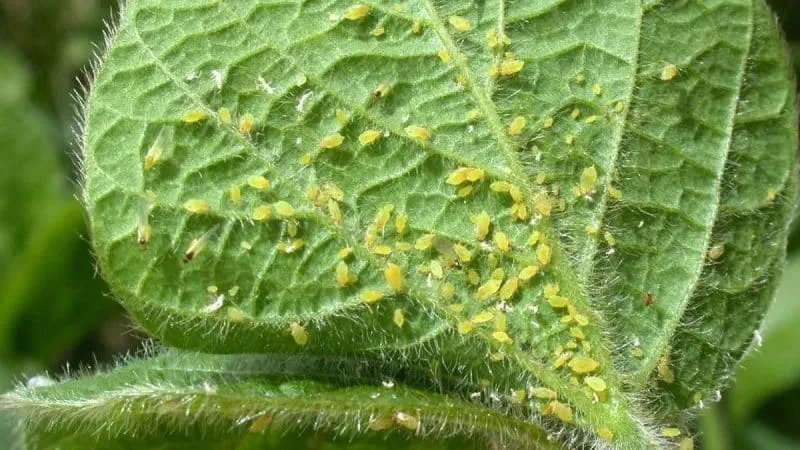
- Leaf Beetles: Black-green beetles with yellow legs that chew large holes in leaves.
- Gooseberry Sawfly (Pale-Legged): Black insects with white legs lay green larvae that skeletonize leaves.
- Yellow Gooseberry Sawfly: Yellow insects with transparent wings; larvae devour leaves, leaving only veins.
- Leafroller Moth: Caterpillars web leaves/buds, distorting growth.
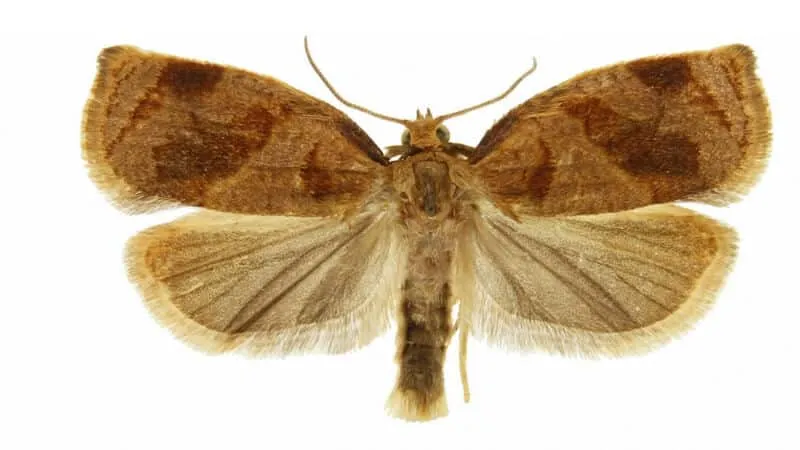
- Gooseberry Moth: Larvae burrow into berries, causing rot.
Prevention: Burn plant debris, scald soil, and apply copper sulfate. For severe infestations, use Decis or Karate (EU-approved insecticides) before flowering.
Non-Chemical Pest Control During Fruiting
If pests appear when berries are present, avoid chemicals. Try:
- Handpicking larger insects.
- Spraying with a strong water jet.
- Introducing beneficial insects (e.g., ladybugs for aphids).
- Herbal sprays (wormwood, yarrow, dandelion).
- Orange peel soap spray: Steep 10 peels in 2 L water for 2 weeks, strain, add soap, and dilute to 10 L.
Conclusion
Diseases and pests are the greatest threats to gooseberries, often causing plant death and crop loss. Infections can spread to other fruit plants.
Early identification and appropriate treatment are essential. Many gardeners prefer organic solutions or eco-friendly chemicals to protect both plants and the environment.







